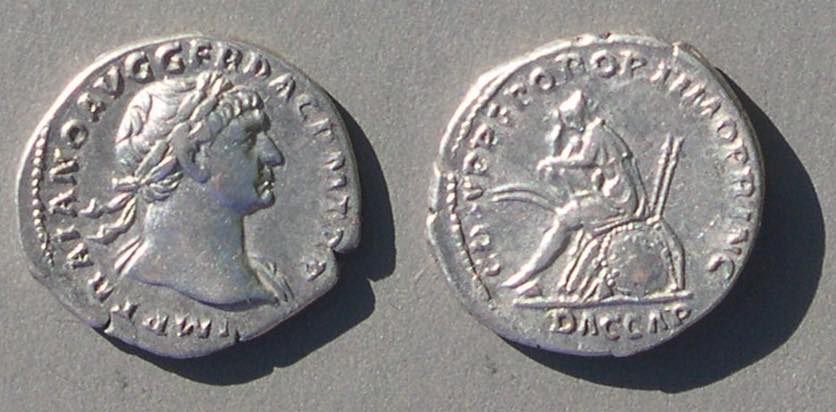 Ancient coins. Themes for collections.
Ancient coins. Themes for collections. Ancient coins. Themes for collections.
Ancient coins. Themes for collections.
What should I collect?
There is no "should" in ancient-coin collecting. Look around at ancient coins a while, read up a bit on them, and then collect what interests you.
This page has two goals:
1) Give beginners an idea of the wide variety of ancient coins and potential collection themes.
2) List reference works collectors could consult to learn more, or much more, about those themes
Click the image to see a list of relevant reference works. If that doesn't work, it simply means I have not yet assembled a linked page of reference works.
What do you mean by "themes"? The coin at the upper right illustrates several. It is a silver denarius of the Roman emperor Trajan, who reigned 98-117. (His name begins at 7:00: IMP TRAIANO ...). It would fit a number of "themes" that you could emphasize:
The portrait series of Roman emperors (This is the most common theme.)
The "five good emperors" (of the second century. This theme is more limited and attainable.)
Types of Trajan, portrait styles of Trajan, one coin of each denomination issued by Trajan (Some collectors concentrate on coins of a particular emperor.)
Historical types (It refers to his Dacian wars. There are books that list coin types that make particular historical references.)
Types related to particular wars (Wars and Rome are associated. Most coin types do not refer to war, but some do.)
Trajan's Dacian war types (He issued several different types explicitly mentioning Dacia--see the "DAC CAP" low on the reverse? "Dacia captured")
Arms and armor (the defeated Dacian on the reverse sits on a pile with two different shapes of shields, spears, and curved Dacian weapons.)
References to geographical regions (Dacia, which is where Romania is now.)
Skip down to the illustrated list of possible themes.
Here is a CoinTalk thread with advice for beginners:
https://www.cointalk.com/threads/for-beginners-who-ask-what-should-i-collect.308319/#post-2950249
and another thread about typical beginners' worries when just getting started:
https://www.cointalk.com/threads/scared-about-collecting-ancients.312927/
Recommendation: Visit the ancients forum of CoinTalk.com, https://www.cointalk.com/forums/ancients/ , and see what people post that interests you. Here is a link to a very long thread in which people posted coins that fit various collecting themes:
https://www.cointalk.com/threads/follow-the-coin-theme-game-ancient-edition-post-%E2%80%98em-if-you-got-%E2%80%98em.300099/
Most ancient-coin collectors do not focus narrowly. Most buy anything that strikes their fancy in addition to having some theme they prefer. Do not think you must eventually pick a collecting theme. These are just to give you ideas and references.
Forum Ancient Coins has a site where members post their collections. To see many real collections,
look here: http://www.forumancientcoins.com/gallery/index.php?cat=1
These coins are not for sale. If you want to see coins for sale, look at my site, Augustus Coins, here http://augustuscoins.com/index.html or this list of ancient-coin dealers.
Here are some theme possibilities. [For the key to abbreviations, see below. "#" gives a rough estimate of the number of types a serious collector might seek.]
Click on the image to go to a page listing related reference works (if the reference-work page has been posted--some have not). See the end of this page for more links.
The portrait-series of the Roman emperors:
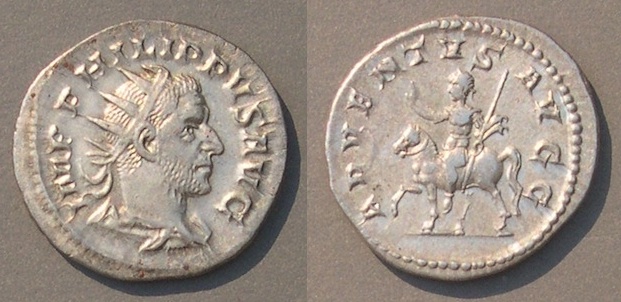 A profile portrait of emperor
A profile portrait of emperor
Philip I "The Arab", 244-249 AD.
A silver "antoninianus" or simply, a "radiate". 22 mm. Common.
IMP PHILIPPVS AVG
ADVENTVS AVGG, Philip riding horse left, raising right hand and holding scepter in left arriving (ADVENTVS) at Rome.
# There are about 70 senior emperors who were recognized at Rome and 200 Romans with portraits on imperial coins including wives, sons, and usurpers.
Reference: The subject is large, but there are single-volume books that have coins of each emperor, such as David Sear's Roman Coins and their Values, 4th edition. (The more-recent edition is in five volumes instead of one.) [No link to a reference works--the subject is too vast.]
Here is a list of emperors and their relatives listed in order of availability from Ras Suarez (based on his book ERIC II) and used with permission.

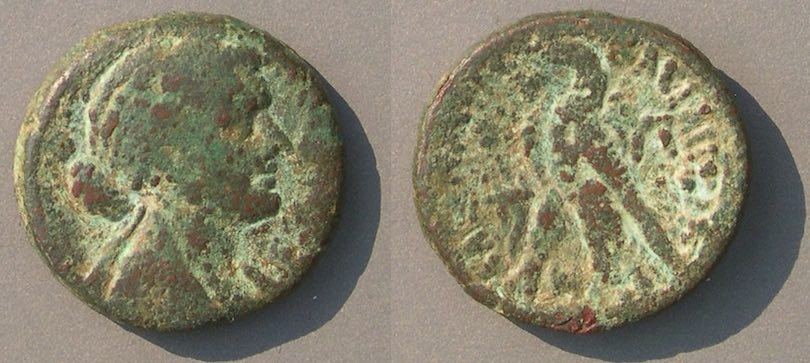
Beautiful Greek coins from City-States:
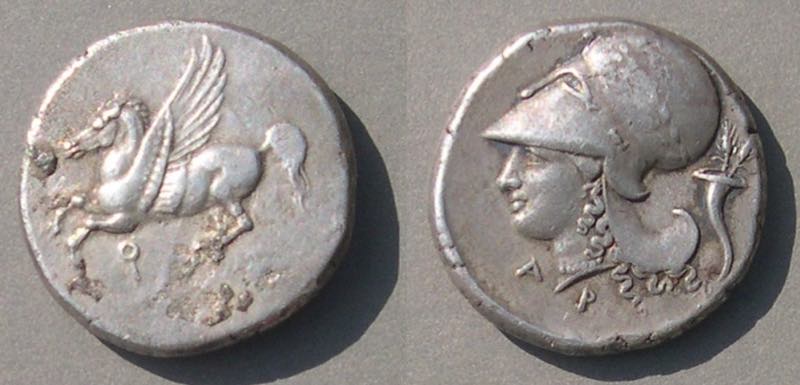 Corinth, silver stater, 21 mm.
Corinth, silver stater, 21 mm.
A lovely rendition of Pegasus flying left
and Athena facing left in a Corinthian helmet (tipped back)
with a cornucopia with two wheat ears behind.
# thousands of types and hundreds of cities
Book reference: David Sear's Greek Coins and their Values in two volumes. Volume I covers Europe and volume II covers Asia. There are many books on Greek coins that have more attractive photos and more discussion, but they do not attempt to show a little bit of everything the way Sear's book does.
[Link to reference works.]
Roman Republican denarii:
 A Roman Repubican denarius of the moneyer C. Minucius Augurinus
A Roman Repubican denarius of the moneyer C. Minucius Augurinus
c. 135 BC, 18 mm
with helmeted head of Roma right, ROMA behind, X below chin.
A representation of the bronze column erected outside the Porta Trigemina to
L.Minucius Augurinus in commemoration of his successful attempt in B.C. 439,
when prefect of the corn market, to reduce the price of corn, as the people were
suffering from a grievous famine. This coin honors the family of the moneyer
by commemorating an event in the distant past.
# c. 500 Republican denarius types
Roman Coins and Their Values, Volume I, by David Sear
[Link to reference works.]
Greek Sicily:
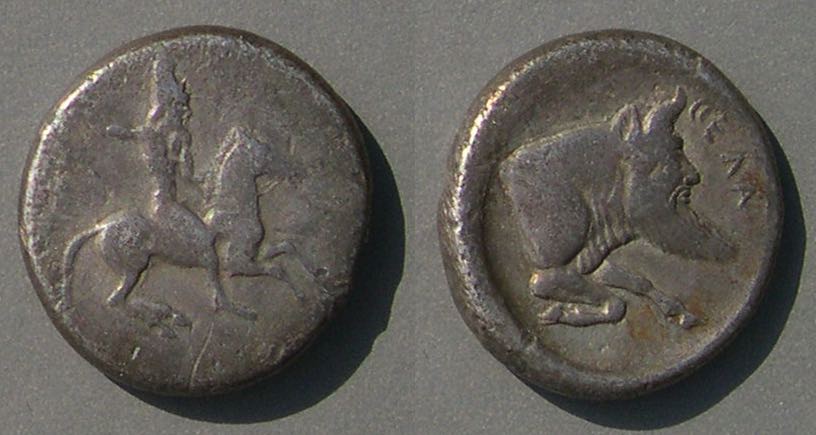 Sicily, Gela. 490/485 - 480/475 BC.
Sicily, Gela. 490/485 - 480/475 BC.
19 mm.
Helmeted naked rider on prancing horse right, wielding spear
forepart of man-headed bull right GEΛA (the city name in Greek) down right
# c. 45 cities, each with many types, some of which are fabulous and the most artistic coins of all time
Book Ref: Hoover, Handbook of Coins of Sicily
[Link to reference works.]
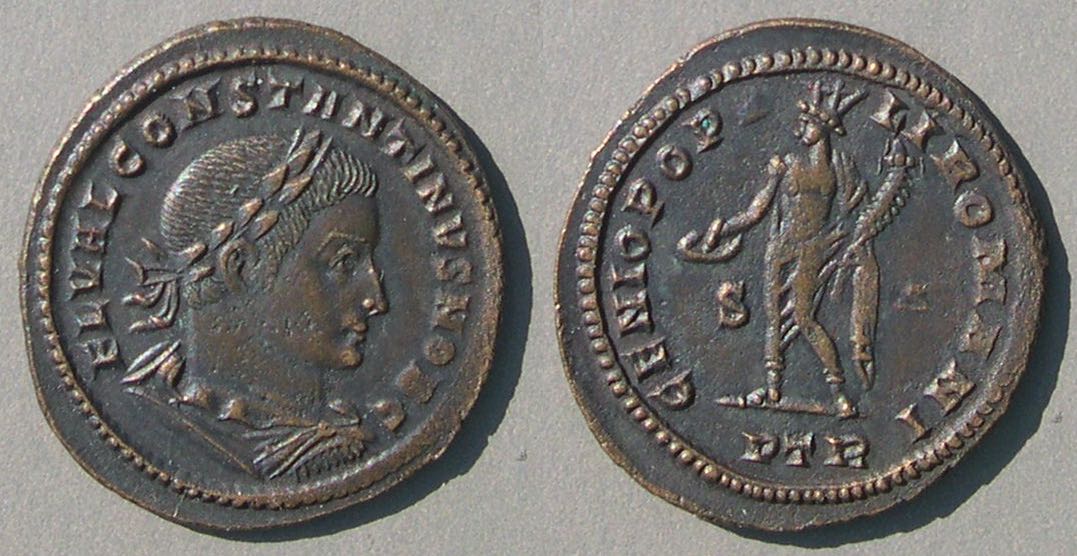 Constantine (Augustus, 307-337) struck as Caesar 306-307
Constantine (Augustus, 307-337) struck as Caesar 306-307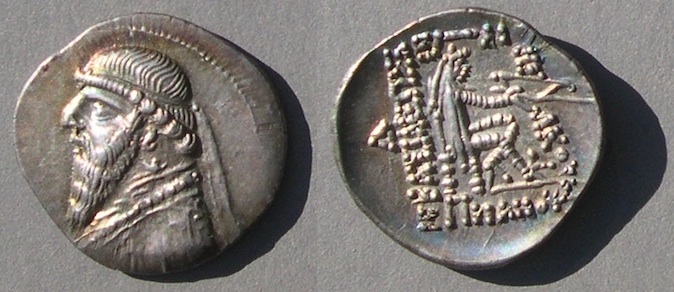 Parthian King Mithradates II, 123-88 BC.
Parthian King Mithradates II, 123-88 BC.
Sasanian:
 Sasanian King Khusru, 590 - 628 AD
Sasanian King Khusru, 590 - 628 AD
Silver drachm, 32 mm.
The most common Sasanian coin ruler.
The reverse type of two attendants on either side of the fire altar of their religion is used by every king for centuries.
# 35 kings, most with similar coins from many mints and dates.
Book Ref: Sasanian Coins by Sellwood, Whitting & Williams
[Link to reference works.]
Byzantine (copper or gold or silver, or all three):
 Byzantine emperor, Justinian, 527-565 AD
Byzantine emperor, Justinian, 527-565 AD
A copper 40-nummia piece.
M = 40 in Greek, for the denomination
ANNO down the left and XXXI down the right for year 31 of his reign:
Mint of Cyzicus: KYZ (Kyzikos) in exergue
Web Reference: "Introduction to Byzantine coins" (my site)
Another web ref: http://www.wegm.com/coins/byindex.htm
Book Ref: Byzantine Coins and their Values, by David Sear
Byzantine Coins (the book, not the pamphlet) by Philip Grierson
[Link to reference works.]
# 2600, not including date varieties (which are numerous)
The "Twelve Caesars":

Nero (54-68 AD), the sixth of the 12 Caesars set,
which begins with Julius Caesar and ends with Domitian.
A silver denarius, 19-18 mm.
NERO CAESAR AVGVSTVS/SALVS
# 12 rulers, each with many types
Book ref: Roman Coins and Their Values, Volume I, by David Sear
[Link to reference works.]
A particular Roman emperor, any emperor, e.g. Probus, Augustus, Trajan, Gordian III, or Maximinus Thrax (The Giant)
 Roman emperor Probus, 276-282 AD.
Roman emperor Probus, 276-282 AD.
23 mm. A surface-silvered "antoninianus" or "radiate" or aurelianus"
IMP C M AVR PROBVS AVG
/SOLI INVICTO, facing quadriga with Sol, the sun god, driving
Bust left, holding spear in right and shield in left, with crested helmet.
Probus is famous for issuing many attractive varieties of obverse bust.
# depends upon the emperor, of course. For this emperor, Probus
there are hundreds (really thousands) of obviously different varieties
Links to web sites emphasizing particular emperors: http://augustuscoins.com/ed/references.html
e.g. For Maximinus Thrax, the Giant: http://augustuscoins.com/ed/Maximinus/Maximinus.html
[No link to reference works, however here are links to sale-catalogs for a few emperors:
http://augustuscoins.com/ed/catalogs/Themes.html ]
# several to dozens to hundreds to thousands, depending upon the emperor and how much minor varieties interest you.
"Biblical" Coins (Coins with some connection to the Bible):
 A "shekel of Tyre" which has been thought to be the type of the
A "shekel of Tyre" which has been thought to be the type of the
"30 pieces of silver" paid to Judas for betraying Jesus to the Romans.
25 mm.
Laureate head of Melquart right
Eagle left
Various symbols in the field, including the date PΞ = 160 of the era of Tyre = 34/5 AD.
# several hundred
Book Ref: Guide to Biblical Coins, by David Hendin (5th or 6th edition) [Link to reference works.]
Early Christian symbolism on Roman coins:
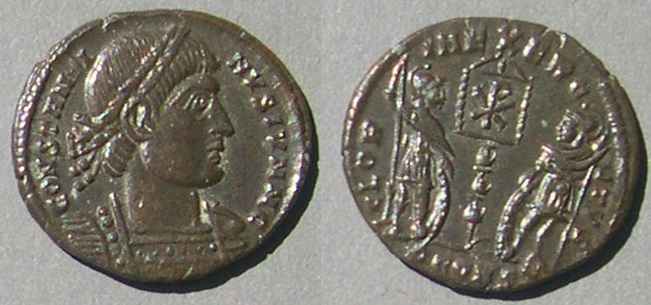 Emperor Constantine II, son of Constantine
Emperor Constantine II, son of Constantine
the first emperor to promote Christianity
Note the chi-rho symbol, a monogram of the first two letters (X P) of "Christ" in Greek
on the standard on the reverse.
Web Ref: http://augustuscoins.com/ed/Christian/ChristianSymbols.html
[That web page has references, but this page you are on is not linked directly to other reference works. I am unaware of sale catalogs with a significant emphasis on Roman coins with Christian symbolism.]
Roman Provincial (= Greek Imperial) Coins (perhaps one from each city that issued them:
 A large (33 mm) provincial coin of Septimius Severus (193-211)
A large (33 mm) provincial coin of Septimius Severus (193-211)
struck at Antioch in Pisidia (in Turkey)
with the local god "mên" on the reverse, with a lunar (moon) crescent behind his shoulders and a small rooster at his feet left. Provincials often have reverse types of local relevance.
Here is a long CoinTalk thread on provincials:
https://www.cointalk.com/threads/roman-provincial-coin-cities-how-many-can-we-cover.300235/
# over 600 cities
[Link to reference works.]
There are very many reference works on the web, but somewhat scattered about. This is not the easiset subject to research, but it is rewarding.
 The Seleucids ruled part of Alexander the Great's empire after his death.
The Seleucids ruled part of Alexander the Great's empire after his death.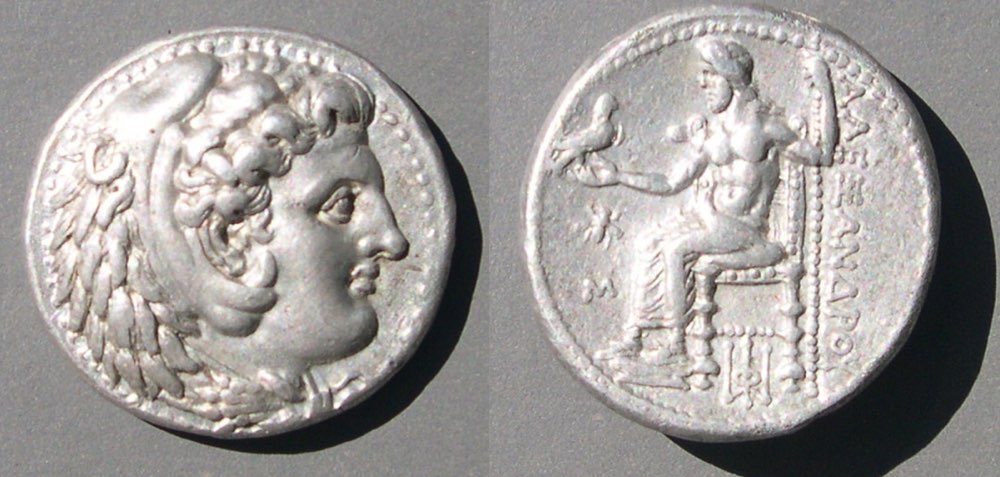 Alexander the Great, 336-323 BC, lifetime issue
Alexander the Great, 336-323 BC, lifetime issue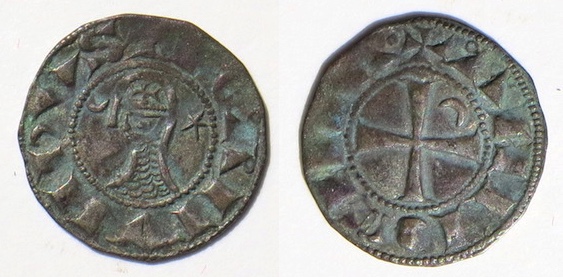 Crusader in helmet left, with cross and chain mail shirt
Crusader in helmet left, with cross and chain mail shirt Figure with sword and holding a severed head
Figure with sword and holding a severed head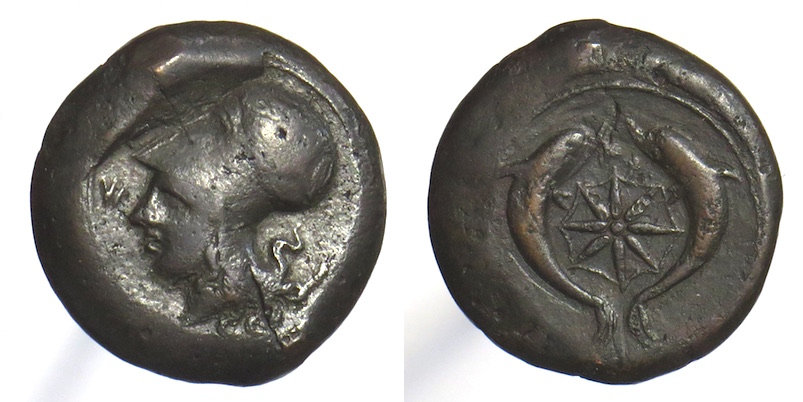 Large and thick coin of Syracuse, Sicily. 344-336 BC
Large and thick coin of Syracuse, Sicily. 344-336 BC
Here is a long list (2000 entries! Created by Ken Steiglitz) of all Greek issuing authorities:
http://augustuscoins.com/ed/catalogs/GreekAuthorities.pdf Roman emperor Commodus, 180-193 AD
Roman emperor Commodus, 180-193 AD
24 mm, thick. Base silver tetradrachm
minted at Alexandria, Egypt, with the image of
a cargo ship and the famous lighthouse of Alexandria.
Struck year 29 (KΘ in exergue). Emmett 2542, Sear 2.5927
Ref catalog: CNG 73 (2006, Sept. 13) 1130 ancients, with a collection of 98 ships on coins
[Link to reference-work page.]
# 200?
 A very common "follis" or "nummus" (27 mm) of Diocletian (284-305).
A very common "follis" or "nummus" (27 mm) of Diocletian (284-305). A tetradrachm of Athens, struck c. 449-413 BC. 23 mm and very thick.
A tetradrachm of Athens, struck c. 449-413 BC. 23 mm and very thick.Book Ref: Handbook of Coins of Northern and Central Greece, by Oliver Hoover, lists
over 200 types, most very rare and seldom seen. The number of types normally seen is far less, unless you count varieties of "New Style" tetradrachms which he did not.
The "New Style" coins of Athens come in hundreds of varieties.
[No links to reference works. There are many.]
Animals (on Greek coins or on Roman coins):
 The Romans and Greeks depicted many exotic animals on coins
The Romans and Greeks depicted many exotic animals on coins
This one is a camel on a coin of Roman emperor Trajan, 98-117 AD, who annexed "Arabia" (now southern Jordan) and used the camel as a symbol of it.
# thousands of types, c. 50 different animal species, more if sea creatures are included.
Book Reference: Ancient Animals and their Coins, by Jasper Burns.
https://www.amazon.com/Ancient-Animals-Their-Coins-Jasper/dp/1979100934/ref
[No link to reference works.]
Horses:

 Maroneia, a city in Thrace, c. 495-449 BC.
Maroneia, a city in Thrace, c. 495-449 BC.
This is a Greek silver drachm, 17 mm, with a horse protome (front half) and a ram's head
# Horses are extremely common on ancient coins, both Greek and Roman.
Many are galloping free, and even more have riders or are pulling chariots.
[No link to reference works.]

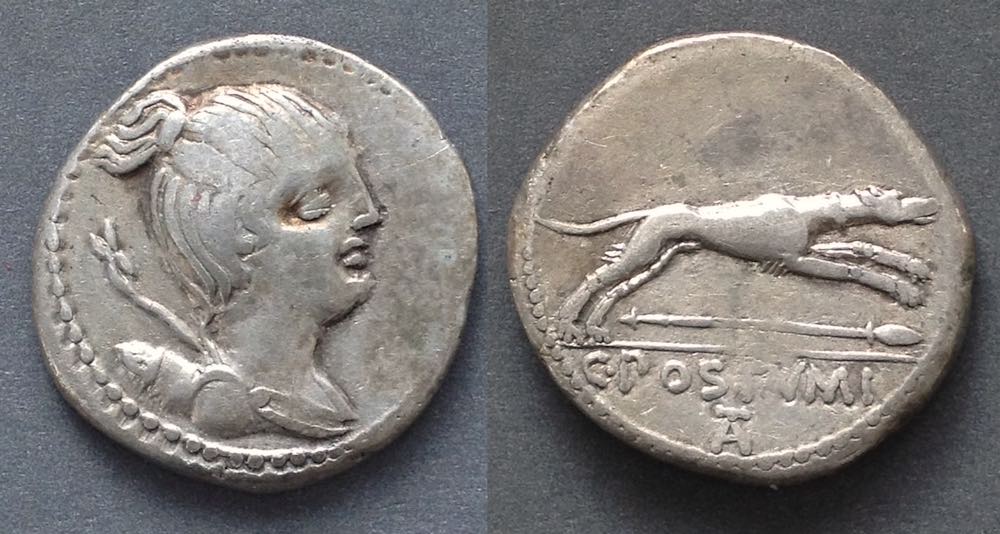 Roman Republican denarius. 19-18 mm.
Roman Republican denarius. 19-18 mm.
 Stater (or Shekel) of Alexander the Great
Stater (or Shekel) of Alexander the Great
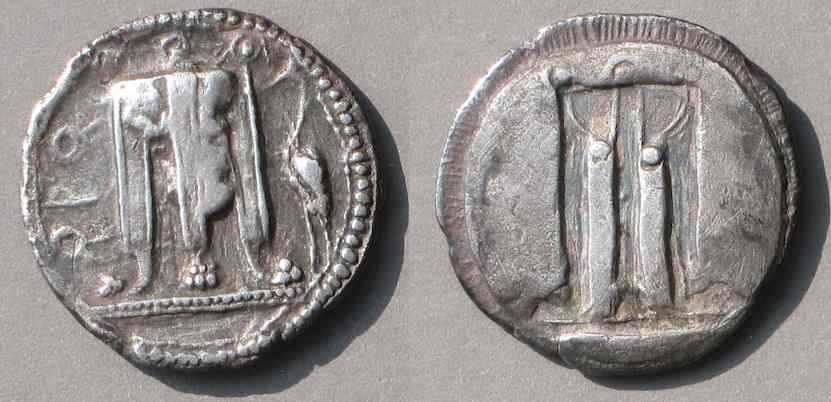 Stater of Kroton, in southern Italy, c. 480-420 BC
Stater of Kroton, in southern Italy, c. 480-420 BC
 A drachm of Roman Alexandria, Egypt
A drachm of Roman Alexandria, Egypt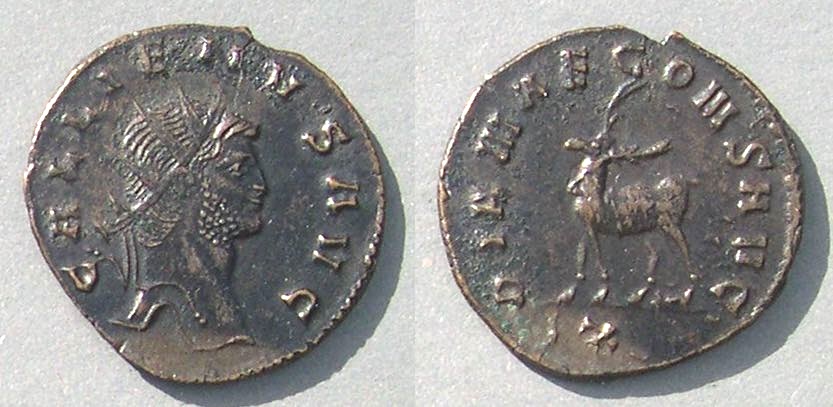 Roman emperor Gallienus, 253-268
Roman emperor Gallienus, 253-268
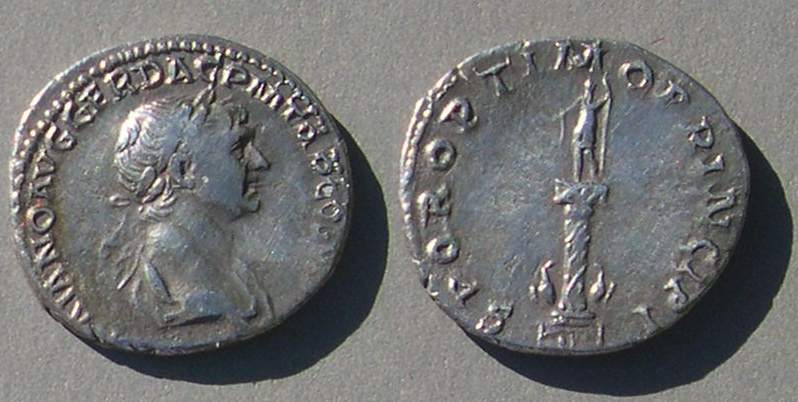 The column of Roman emperor Trajan, 98-117
The column of Roman emperor Trajan, 98-117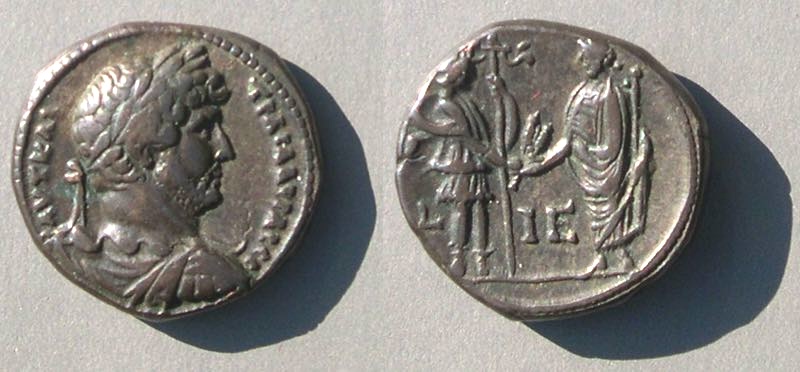 A tetradrachm of Alexandria, Egypt, minted under Hadrian, showing him being received by (the personification of) Alexandria on his visit of year 15 (L IE).
A tetradrachm of Alexandria, Egypt, minted under Hadrian, showing him being received by (the personification of) Alexandria on his visit of year 15 (L IE). Akragas in Sicily (a.k.a. Agrigentum in Roman times)
Akragas in Sicily (a.k.a. Agrigentum in Roman times)
Greek Kings:
 Ptolemy I, King of Egypt 305-283 BC
Ptolemy I, King of Egypt 305-283 BC
Struck at Alexandria.
Tetradrachm. 27 mm. 14.21 grams.
His bust right
Ptolemaic eagle standing left on a thunderbolt, "of King Ptolemy" in Greek.
Book Reference: Royal Greek Portrait Coins, by Edward Newell is an excellent, inexpensive, and thin reference work with substantial stories of the rulers and one coin of each ruler pictured.
# c. 200 kings for all dynasties and regions. Specializing by dynasty or region is common
(see "Seleucid Kings" and "Alexander the Great" above)
[No link to reference works.]
Specific Victories:
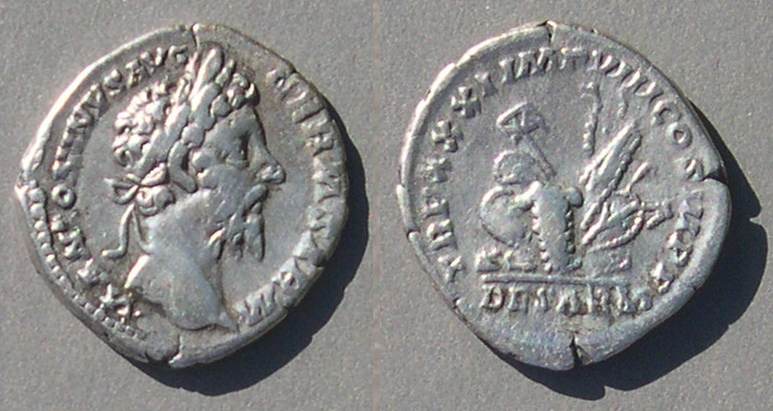 Marcus Aurelius, 161-180 AD
Marcus Aurelius, 161-180 AD
defeats the Sarmatians
DE SARM in exergue,
TRP XXXI IMP VIII COS II PP around a pile of arms
M ANTONINVS AVG GERM SARM around his portrait
Silver denarius, 20-18 mm.
# hundreds, but specializing by emperor is common.
Augustus, Trajan, Marcus Aurelius, Septimius Severus, Gallienus and others have numerous types from the theme.
Book reference: Roman Historical Coins, by Clive Foss, lists by date all Roman events (including victories) that are mentioned on coins and for each date lists the coins that reference them. 335 pages with one or two coins illustrated per page.
[No link to reference works.]
Carthage:
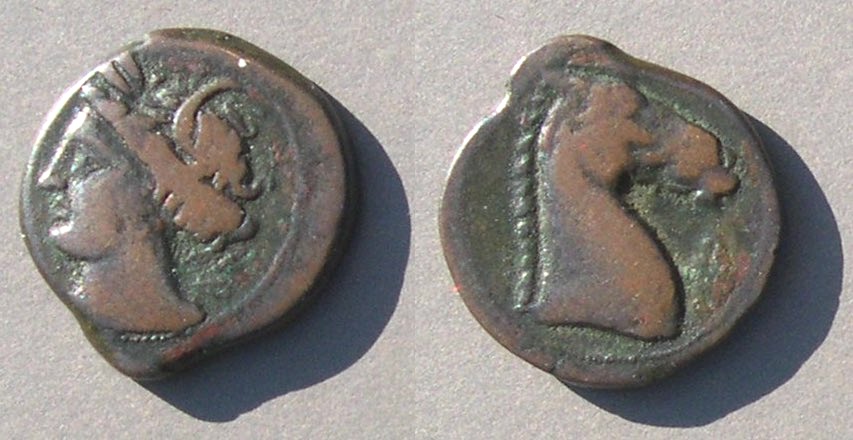
Bronze of Carthage, c. 300-264 BC.
19-18 mm.
head of Tanit left/horse head right
# a hundred types, most somewhat similar to each other, not counting the coins of Roman and Byzantine Carthage
(It became a mint again in late Roman times c. 296 under Diocletian.)
[No link to reference works.]
"Campgates" Mostly late Roman copper coins with city gates:
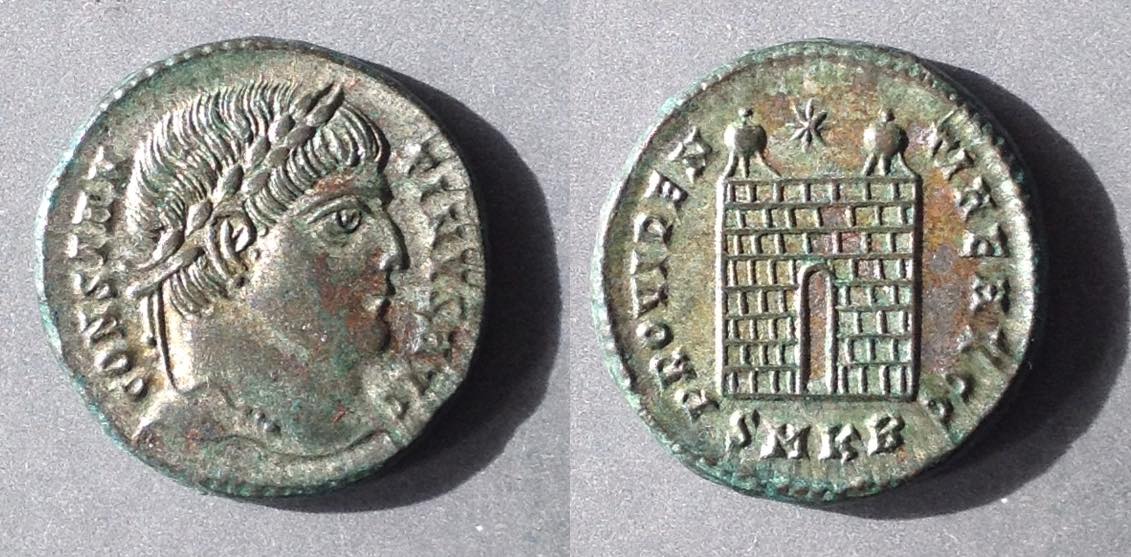 Constantine (307-337)
Constantine (307-337)
A lightly surface-silvered AE of 18 mm
Camp gate (city gate), struck at Cyzicus
(mintmark SM K B where K is for Kyzicos, B is for the second workshop,
and SM abbreviates Sacra Moneta, Sacred Mint)
These are extremely common.
# a few types for several emperors, but also a dozen mints, and hundreds of varieties in this time period and other, similar, reverses in other time periods. This example depicts 8 tiers of stones. Some collectors even care about the number of tiers which can vary from 6 to 16.
Web Ref: http://www.beastcoins.com/Topical/Architecture/Campgate.htm
[No link to reference works.]
A Type Set for emperors Valentinian (364-375) and later:
 Valens, 365-378 (Valens is most famous for losing the disastrous "Battle of Adrianople".)
Valens, 365-378 (Valens is most famous for losing the disastrous "Battle of Adrianople".)
An "AE3." 17 mm.
GLORIA ROMANORVM
emperor dragging captive right, holding standard in left
ANTS = Antioch mint, 6th workshop
# From Valentinian through Theodosius II (364-450 AD) there were 10 emperors and a few wives and usurpers, 83 copper types, each issued by 1-5 emperors.
Web Ref: http://augustuscoins.com/ed/ricix/
Book Ref: RIC IX covers most of this period and RIC X covers the rest.
[No link to reference works. See that site for some references. Very few sale catalogs emphasize this period because the coins are too inexpensive.]
 Roman emperor Hadrian (117-138 AD)
Roman emperor Hadrian (117-138 AD) Victory walking left, holding wreath and palm branch over left shoulder
Victory walking left, holding wreath and palm branch over left shoulder [No link to reference works.]
Late Roman silver coins:
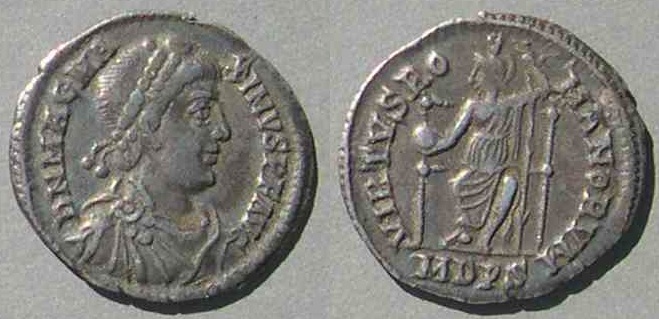 A siliqua of Magnus Maximus (383-388)
A siliqua of Magnus Maximus (383-388)
17 mm.
Struck at Milan
VIRTVS RO-MANORVM
# hundreds.
Book reference: Roman Silver Coins, volume V, by Cathy King
is devoted to late Roman silver.
A web page of mine: http://augustuscoins.com/ed/siliqua/siliqua.html
[No link to reference works.]
British references:
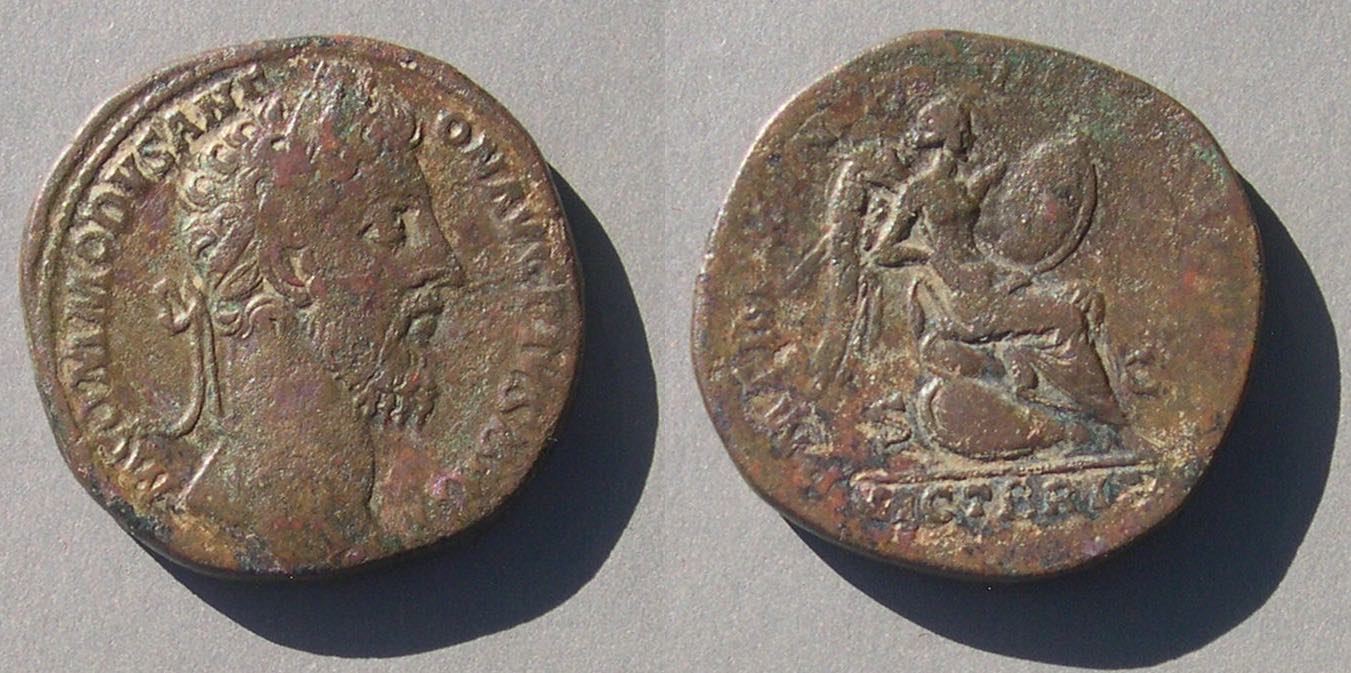 VICT BRIT in exergue on a large sestertius (31 mm) of Roman emperor
VICT BRIT in exergue on a large sestertius (31 mm) of Roman emperor
Commodus (180-193 AD)
with Victory seated right on a pile of arms and holding a shield,
a design later adopted for English pennies.
Many collectors in England (and elsewhere) collect coins with references to Britain.
Book reference: Coinage in Roman Britain, by Richard Reece, is just what it says, but not a list of types that mention Britain.
The Coinage of Roman Britain, by Gilbert Askew, is old (1951) but a clear list of 888 types that reference Britain.
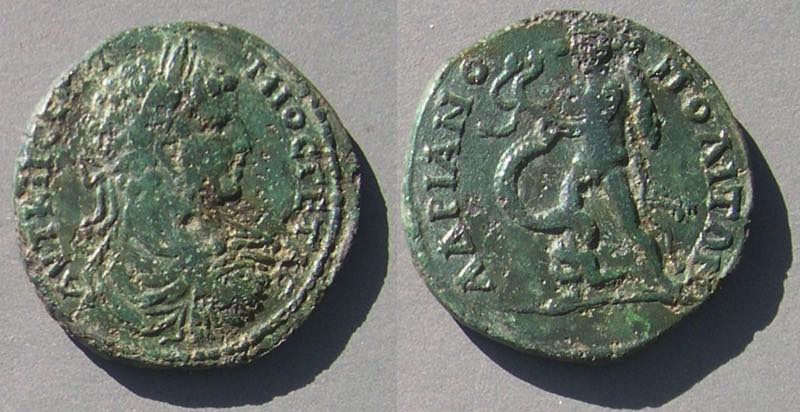 Hercules slaying the multi-headed Hydra
Hercules slaying the multi-headed Hydra APOLL SALVTARI
APOLL SALVTARI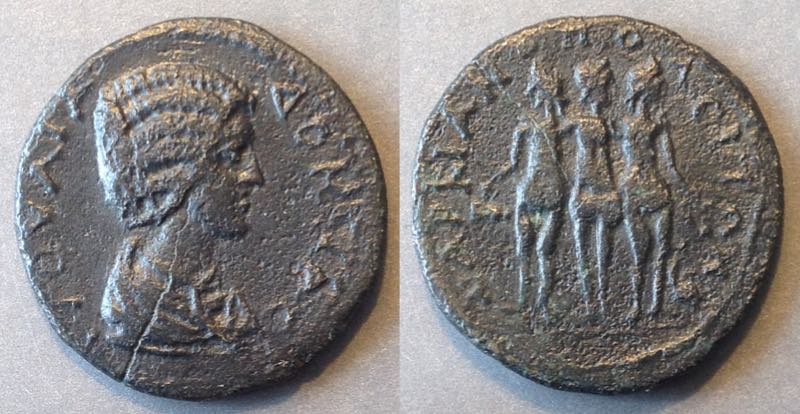 The three graces on a provincial coin from Marcianopolis
The three graces on a provincial coin from Marcianopolis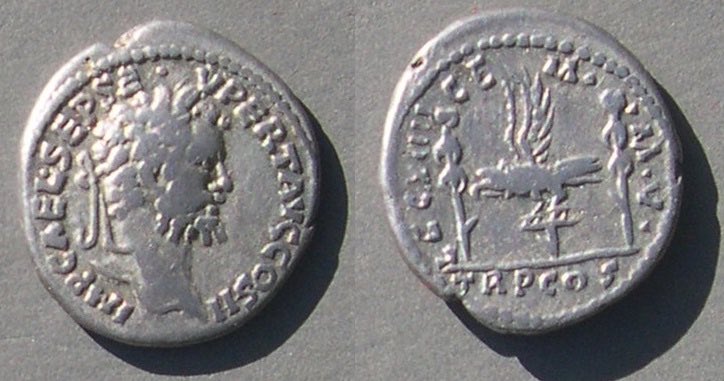 LEG[ion] XIIII GEM[ini] M V
LEG[ion] XIIII GEM[ini] M V
Tetradrachms of Roman Syria:
 Philip I (244-249)
Philip I (244-249)
Tetradrachm of Antioch
27-25 mm and thick. Base silver.
ANTIOXIA in exergue, identifying the mint city
Book Ref: The Syro-Phoenician Tetradrachms from 57 BC to AD 253, by Michael Prier
# Prier list 1743 types, most of which are minor legend varieties, from 30 cities in the region.
[No link to other reference works. There are many.]
A silver "argenteus" of Diocletian.
20-19 mm. 3.30 grams. RIC VI Ticinum 20a, "c. AD 300".
"XCVI" is "96" in Roman numerals and gives its value, "96 to the Roman pound of silver."
I have seen collections with (partial) emphasis on siliquae, quadrantes, quinarii, medium bronzes, late Roman follis fractions from Trier, etc.
Web Reference: http://augustuscoins.com/ed/argenteus/
[Link to reference works on the argenteus denomination.]
 An 18 mm silver denarius commemorating the death of Antonianus Pius (138-161).
An 18 mm silver denarius commemorating the death of Antonianus Pius (138-161).More themes. There are many more themes that would make a good collection (most not listed here):
The Greek gods
VOTA coins mentioning vows of the emperor for ten years of reign
Key to abbreviations on this page above:
(Click on the image to find references on the theme.)
# A very crude guess at the number of very distinct types to be collected, not counting varieties
mm millimeters, the diameter of the illustrated coin. For comparison, a US dime is 18 mm, a cent 19 mm, and a quarter 24 mm. Ancient coin sizes are measured in mm, not inches.
RIC Roman Imperial Coinage, the major reference book published in ten volumes.
Ref Reference work by title and author, if a book. Most themes are discussed in many books and web sites. Here is a index page that may list more sources for a given topic.
Recommendation: Visit the ancients forum of CoinTalk.com, https://www.cointalk.com/forums/ancients/
or Numis Forums,
https://www.numisforums.com/?forumId=3%2C15%2C7%2C9%2C14%2C21%2C16
and see what people post that interests you. Here is a link to a very long thread in which people posted coins that fit various collecting themes:
https://www.cointalk.com/threads/follow-the-coin-theme-game-ancient-edition-post-%E2%80%98em-if-you-got-%E2%80%98em.300099/
Forum Ancient Coins has a site where members are invited to post their collections. To see many real collections, look here.
Return to this site's main Table of Contents page.